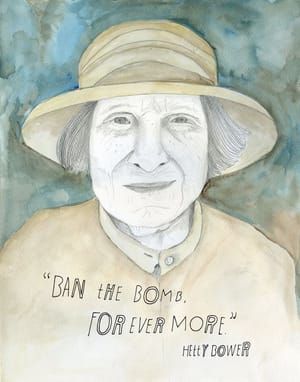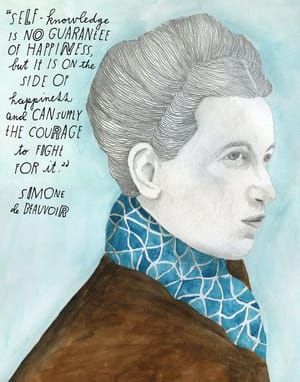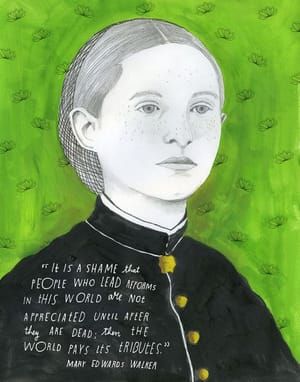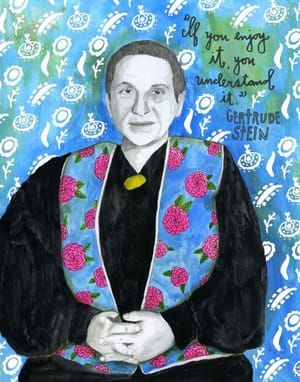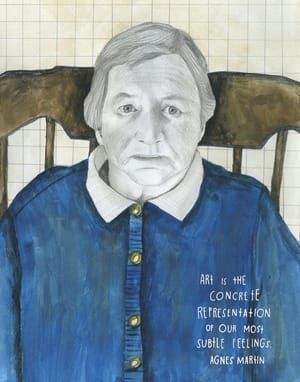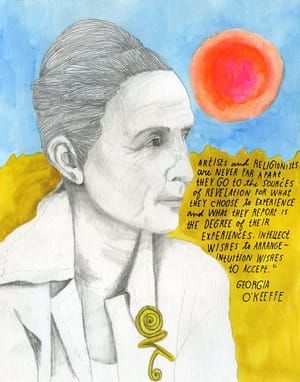
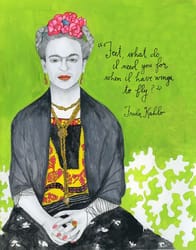
Frida Kahlo, 2013
Lisa Congdon
Mexican painter Frida Kahlo (July 6, 1907 – July 13, 1954) remains best-known for her vibrant self-portraits, which comprise 55 of her 143 paintings and combine elements from traditional Mexican art with a surrealist aesthetic. This dual mesmerism with indigenous Mexican culture and the spirit of the new imbued Kahlo’s entire sensibility – she even insisted on stating July 7, 1910 as her birth date, rather than the correct date her birth certificate reflected, in order to make her birth coincide with the start of the Mexican revolution and thus align her life with the dawn of modern Mexico.
Kahlo was befallen by a disproportionate amount of medical misfortune. As a young child, she contracted polio, which prevented her right leg from developing fully – an imperfection she’d later come to disguise with her famous colorful skirts. As a teenager, while studying at Mexico’s prestigious Preparatoria school as one of only 35 girls, she was in a serious traffic accident, which left her with multiple body fractures and internal lesions inflicted by an iron rod that had pierced her stomach and uterus. It took her three months in full-body cast to recover and though she eventually willed her way to walking again, she spent the rest of her life battling frequent relapses of extreme pain and enduring frequent hospital visits, including more than 30 operations.
It was during her time in recovery that Kahlo first began painting, at first as a way of occupying herself while bedridden. Her mother even had a special easel made for her in order to be able to paint in bed with her father’s set of oil paints and brushes.
“I paint myself because I am so often alone and because I am the subject I know best,” she famously reflected on her self portraits.
Two years after the accident, in 1927, she met the painter Diego River, whose work she’d come to admire, and he went on to encourage and mentor her work. In 1929, despite her mother’s protestations, the two were wedded and one of art history’s most notoriously tumultuous marriages commenced. Both had multiple affairs, the most notable of which for bisexual Kahlo were with French singer, dancer, and actress Josephine Baker and Russian Marxist theorist Leon Trotsky.
Despite her work being inducted into the world’s most prestigious art institution when the Louvre purchased one of her self portraits in 1939, Kahlo didn’t reach wide critical acclaim until the early 1980s and the advent of the Neomexicanismo movement. Previously, she had been frequently reduced in historical accounts to “Diego Rivera’s wife.” Today, her work endures as one of the most prominent and singular voices in 20th-century art.
In her final days, shortly before turning 47, Kahlo wrote in her diary, “I hope the exit is joyful — and I hope never to return.”
Learn more: Smithsonian Magazine (https://www.smithsonianmag.com/arts-culture/frida-kahlo-70745811/?c=y&story=fullstory)
What do Buddhist artist Agnes Martin, Hollywood inventor Hedy Lamarr, and French-Cuban author Anaïs Nin have in common? Their names may not conjure popular recognition, and yet, for Lisa Congdon and Maria Popova, these women represent a particular breed of cultural trailblazer: female, under-appreciated, badass. They are “Reconstructionists,” as the writer-illustrator duo call them – and for the next year, they’ll be celebrated on a blog of the same name. Every Monday for 12 months, The Reconstructionists will debut a hand-painted illustration and short essay highlighting a woman from fields such as art, science, and literature. The subject needn’t be famous, but she will, as Popova, the creator of Brain Pickings, puts it, “have changed the way we define ourselves as a culture." We spoke with Popova, and illustrator Congdon, about the inspiration....
[http://storyboard.tumblr.com/post/41698890843/the-reconstructionists-celebrating-badass-women]
Uploaded on Jan 23, 2018 by Suzan Hamer
Lisa Congdon
artistArthur
Wait what?


